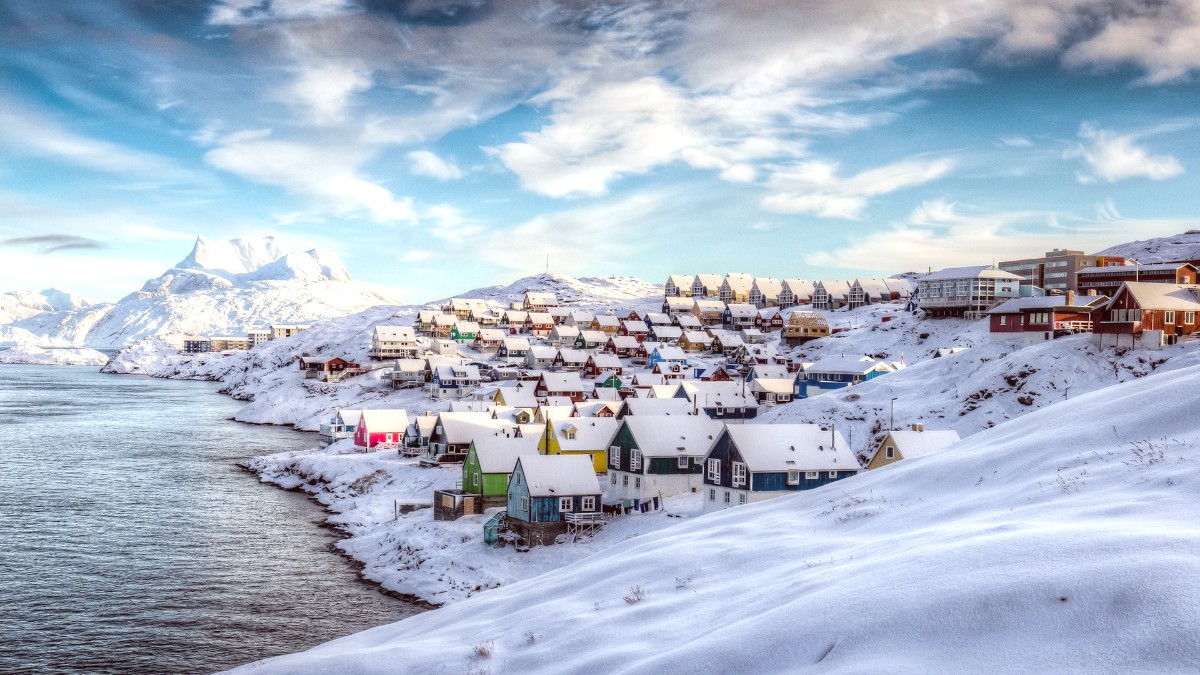
Greenland
Nuuk sits on the southwest coast of Greenland, at the mouth of the Nuup Kangerlua (Nuuk Fjord), the second-largest fjord system in the world. This location places it within a vast and rugged landscape. To the west, the expansive Davis Strait separates Greenland from Baffin Island, Canada. To the east, the formidable Greenland Ice Sheet dominates the island's interior, an immense frozen expanse covering over 80% of Greenland's landmass.
Nuuk is a rich and complex history, stretching back thousands of years. Its story begins with the early Inuit cultures, who settled the area drawn by its abundant marine life and sheltered fjord system. Archaeological evidence suggests continuous human presence in the region for over 4,500 years, with successive waves of Paleo-Inuit and Thule cultures adapting to the Arctic environment.
The modern history of Nuuk began in 1728 when the Norwegian missionary Hans Egede founded the mission of Godthåb (Good Hope) at the site. This became the first permanent Danish settlement in Greenland, functioning as a trading post, mission, and administrative hub. Today, Nuuk is the political, economic, and cultural capital of Greenland, exemplifying the island's transition to a self-governing nation within the Kingdom of Denmark.
Population: Around 19,000 residents, making it Greenland's largest settlement.
Language: Greenlandic (Kalaallisut) and Danish are official. English use is common in tourist areas.
Currency: Danish Krone (DKK). Credit cards find wide acceptance.
Climate: Subarctic, with cold, snowy winters and cool, mild summers. Weather changes rapidly.
Transportation: Nuuk Airport (GOH) stands as the primary gateway, with flights connecting via Copenhagen or Reykjavik. Within the city, public buses and taxis are available.
Cuisine: Meals focus on fresh seafood, marine mammals, and game, with Danish and international influences found.
Cost: Nuuk presents as a high-cost destination due to its remote location and reliance on imported goods.
A picturesque old town featuring historic buildings, Nuuk Cathedral, and the Hans Egede statue.
Exhibits Greenland's history and Inuit culture, including the Qilakitsoq mummies.
The second-largest fjord system, ideal for boat tours, whale watching (summer), and iceberg viewing.
A modern, architecturally striking building hosting arts and cultural events.
Hiking on trails like Lille Malene, kayaking, and Northern Lights viewing in winter.
The city itself occupies a peninsula, characterized by its hilly terrain and rocky outcrops. This provides numerous viewpoints offering stunning vistas of the fjord, surrounding mountains like Sermitsiaq, and the open ocean. Nuuk's geography means its connections to the wider world are mainly by air and sea. There are no roads linking Nuuk to other settlements in Greenland; movement between towns calls for flights or coastal ferry services.
The city's harbor remains ice-free year-round due to the warm West Greenland Current, a branch of the North Atlantic Current. This supports constant maritime activity, from fishing boats to cruise ships. The Nuuk Fjord system stretches deep inland, presenting a sheltered environment for boat tours and offering glimpses of glaciers, waterfalls, and isolated settlements.
Nuuk's distinct position, at the meeting point of a deep fjord and the open ocean, shapes its climate, ecosystem, and the way of life for its residents. The nearby mountains offer protection from some of the strongest winds, yet the Arctic environment remains a powerful force, forming daily life and travel possibilities. The city's layout adapts to this terrain, with buildings frequently constructed on slopes or around rock formations, creating a distinct urban landscape woven into the natural surroundings.
Nuuk is more than just a city; it is a living example of how communities flourish in one of the world's most dramatic environments. It functions as a base for exploring the grand Arctic landscapes while offering insights into an unique culture. Prepare for a journey where modern life meets ancient traditions, all set against a backdrop of unparalleled natural beauty.
Nuuk's continuous human presence dates back over 4,500 years with early Inuit cultures. The Norse arrived around 985 AD, though their settlements were further south. The modern era began in 1728 with the founding of Godthåb.
In 1979, Godthåb was officially renamed Nuuk as part of a broader movement asserting Greenlandic identity and self-governance. The city's historical sites, from the colonial harbor with its charming old buildings to the Greenland National Museum housing ancient artifacts and the Qilakitsoq mummies, offer tangible connections to its long and layered past.
Archaeological findings point to human presence over 4,500 years, with Paleo-Inuit and Thule cultures adapting to the Arctic.
Erik the Red led Norse settlers to Greenland around 985 AD, establishing settlements mainly in the South and Southwest.
In 1728, Hans Egede founded Godthåb, marking the beginning of permanent Danish settlement and administration.
In the 20th century, as Greenland gained more autonomy from Denmark, Godthåb was officially renamed Nuuk (meaning "The Headland" in Greenlandic) in 1979.
The official currency is the Danish Krone (DKK). Credit cards (Visa, Mastercard, Dankort) are widely accepted. ATMs are available for cash withdrawals. Carrying some DKK cash is a good idea for small purchases.
Nuuk counts among the most expensive travel destinations globally. This stems from its remote location and reliance on imported goods. Careful budget planning is wise to avoid surprises.
Tipping is not customary or expected in Greenland. Service charges are usually included in the prices of goods and services. A small gratuity for exceptional service is appreciated but not mandatory.
Buying groceries from local supermarkets like Brugseni and Pisiffik and preparing your own meals is a great way to save. Many accommodations offer kitchen access.
Using Nuup Bussii, the city's public bus system, for moving around town is more economical. Taxis, while convenient, carry higher costs for daily use.
Nuuk offers many complimentary attractions. Explore the city on foot, trek the numerous trails, visit landmarks like the Hans Egede statue, or stroll through the picturesque Colonial Harbour.